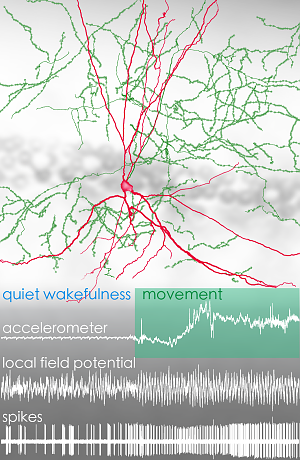 Bistratified cell in rat hippocampus. Reconstruction of the complete dendritic tree (red) and representative part of the axon (green) of a bistratified cell recorded and juxtacellularly labelled in the CA1 area of the hippocampus of a freely moving rat. Traces show the output of an accelerometer, the local field potential and filtered spikes, both recorded by the glass electrode. The cell increased its firing rate and changed to a more regular rhythmic firing pattern during transition from quiet wakefulness to movement.
Bistratified cell in rat hippocampus. Reconstruction of the complete dendritic tree (red) and representative part of the axon (green) of a bistratified cell recorded and juxtacellularly labelled in the CA1 area of the hippocampus of a freely moving rat. Traces show the output of an accelerometer, the local field potential and filtered spikes, both recorded by the glass electrode. The cell increased its firing rate and changed to a more regular rhythmic firing pattern during transition from quiet wakefulness to movement.Neuropeptides and GABA are co-expressed and co-released by hippocampal interneurons. Bistratified and O-LM cells innervate segregated dendritic domains of pyramidal cells and co-release GABA and somatostatin acting on pre- and postsynaptic receptors. How do the activity patterns of these peptidergic/GABAergic interneurons support behaviour? Katona et al. recorded, labelled and identified individual interneurons in freely-moving rats and investigated their firing activity during movement and sleep in relation to hippocampal network oscillations. They found that behavioural and network states differentiate the firing of somatostatin-expressing bistratified and O-LM interneurons in the hippocampus. During movement, the two cell types cooperate temporally, firing at the trough of theta oscillatory cycles but at different frequencies. In contrast, during sleep, the two cell types dissociate in their function; bistratified cells are strongly active while O-LM cells decrease firing.
The results suggest that segregated glutamatergic inputs to CA1 pyramidal cell dendrites from the entorhinal cortex and the CA3 area are differentially modulated by GABA and somatostatin during behaviour.